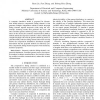Free Online Productivity Tools
i2Speak
i2Symbol
i2OCR
iTex2Img
iWeb2Print
iWeb2Shot
i2Type
iPdf2Split
iPdf2Merge
i2Bopomofo
i2Arabic
i2Style
i2Image
i2PDF
iLatex2Rtf
Sci2ools
WCNC
2008
IEEE
2008
IEEE
Simulation of Doubly-Selective Compound K Fading Channels for Mobile-to-Mobile Communications
A computer simulation model is proposed for discretetime doubly-selective compound-K fading channel. It first generates multiple independent mobile-to-mobile Rayleigh fading Channel Impulse Response (CIR) using the nonisotropic scattering model, then generates the cross- and auto-correlated gamma shadowing matrix using the combination of the memoryless nonlinear transformation (MNLT) method and the decomposition methods. It then combines the complex Rayleigh CIR with the gamma shadowing matrix to yield the doubly-selective fading channel CIR whose envelop follows the compound K distribution. Simulation examples demonstrate that the proposed method can effectively produce compound K fading channel responses with satisfactory statistical properties.
| Added | 01 Jun 2010 |
| Updated | 01 Jun 2010 |
| Type | Conference |
| Year | 2008 |
| Where | WCNC |
| Authors | Yuan Liu, Jian Zhang, Yahong Rosa Zheng |
Comments (0)

